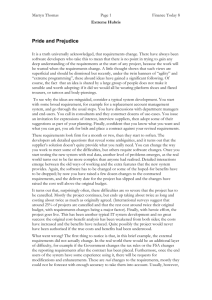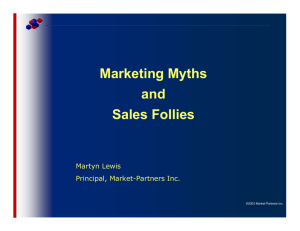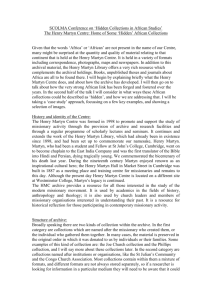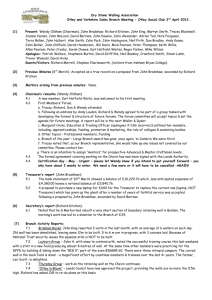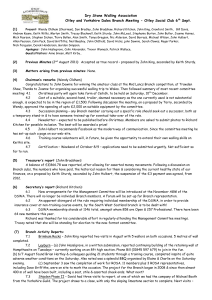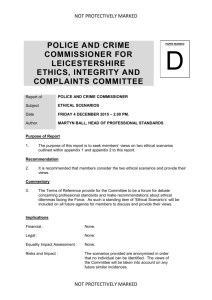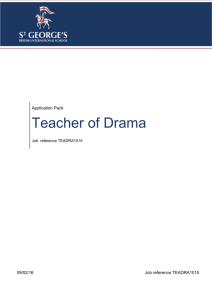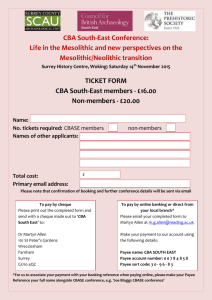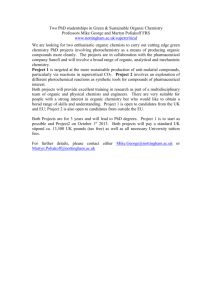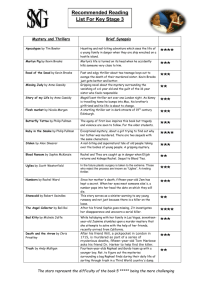EBSCOhost - William Carey University
advertisement
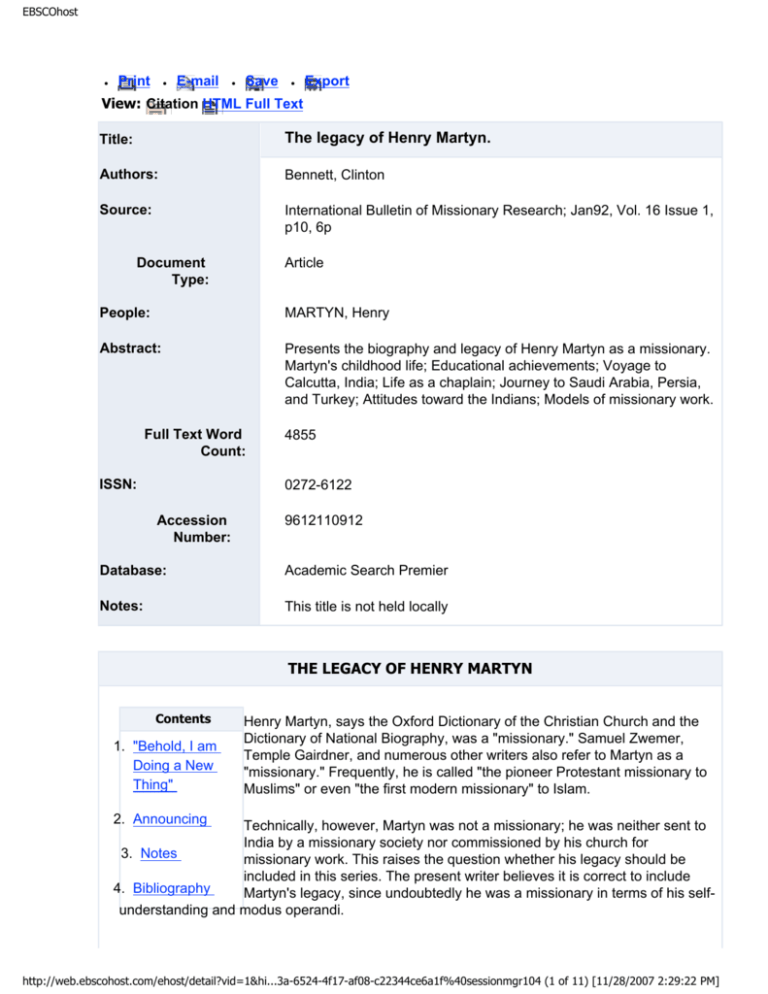
EBSCOhost ● Print ● E-mail ● Save ● Export View: Citation HTML Full Text Title: The legacy of Henry Martyn. Authors: Bennett, Clinton Source: International Bulletin of Missionary Research; Jan92, Vol. 16 Issue 1, p10, 6p Document Type: Article People: MARTYN, Henry Abstract: Presents the biography and legacy of Henry Martyn as a missionary. Martyn's childhood life; Educational achievements; Voyage to Calcutta, India; Life as a chaplain; Journey to Saudi Arabia, Persia, and Turkey; Attitudes toward the Indians; Models of missionary work. Full Text Word Count: ISSN: 4855 0272-6122 Accession Number: 9612110912 Database: Academic Search Premier Notes: This title is not held locally THE LEGACY OF HENRY MARTYN Contents 1. "Behold, I am Doing a New Thing" Henry Martyn, says the Oxford Dictionary of the Christian Church and the Dictionary of National Biography, was a "missionary." Samuel Zwemer, Temple Gairdner, and numerous other writers also refer to Martyn as a "missionary." Frequently, he is called "the pioneer Protestant missionary to Muslims" or even "the first modern missionary" to Islam. 2. Announcing Technically, however, Martyn was not a missionary; he was neither sent to India by a missionary society nor commissioned by his church for 3. Notes missionary work. This raises the question whether his legacy should be included in this series. The present writer believes it is correct to include 4. Bibliography Martyn's legacy, since undoubtedly he was a missionary in terms of his selfunderstanding and modus operandi. http://web.ebscohost.com/ehost/detail?vid=1&hi...3a-6524-4f17-af08-c22344ce6a1f%40sessionmgr104 (1 of 11) [11/28/2007 2:29:22 PM] EBSCOhost Himself influenced by missionaries, especially by David Brainerd (1718-47) and William Carey (1761-1834), Martyn in turn influenced countless others, too numerous to mention, and, as Eugene Stock wrote in the History of the Church Missionary Society: Though his name does not actually honour the CMS roll of missionaries, it is a recollection to be cherished that he was really the society's first English candidate; and though his career was brief, and he was never technically a missionary, yet his unreserved devotion to Christ's cause, and the influence of his name and character upon succeeding generations, entitle him to be forever regarded as in reality one of the greatest missionaries.[ 1] Having offered himself to the Church Missionary Society (CMS), Martyn was unable to proceed as a candidate because the sudden loss of his patrimony left his sister, Sally, dependent on him. This made it impossible for him to accept "the subsistence allowance of a missionary."[ 2] Instead, he accepted the post of chaplain in the East India Company's Service--a post secured for him by Charles Grant (1746-1823), the influential, evangelical East India Company Director who believed it his duty to "improve" the moral and spiritual welfare of India. He began by recruiting chaplains of higher caliber than the majority, who devoted more time to acquiring money than they did to the "cure of souls." Martyn gratefully accepted the appointment, though he would have been "infinitely better pleased to have gone out as a missionary, as poor as the Lord and his apostles."[ 3] He saw his task in India as primarily to further the cause of Christian mission. He recorded in his journal, "Walked by moonlight, reflecting on the mission. . . . even if I never should see a native converted, God may design, by my patience and continuance in the work, to encourage future missionaries."[ 4] The following appraisal of Martyn's legacy will outline his life and career, and then examine four areas in which Martyn's missionary thinking, strategy, and method are particularly noteworthy. Childhood Henry Martyn was born February 18, 1781, in Truro, Cornwall, where his father, John--an amateur mathematician and a former tin miner--had gained promotion as head clerk of a Truro merchant house. Henry, who suffered from tuberculosis from infancy, attended Truro Grammar School from where he entered St. John's College, Cambridge, in 1797, after applying unsuccessfully to Corpus Christi, Oxford. At St. John's he had the advantage of following his friend John Kempthorne (1775-1838), whose graduation as Senior Wrangler in 1797 had already set Martyn a goal to emulate. It was at Cambridge, too, that Charles Simeon (17591836), Fellow of King's and vicar of Holy Trinity, was leading the Evangelical Revival within the Church of England, much stimulated by the theology of the Wesley brothers, whose Methodists now formed a corporate body distinct from the Established Church. In Cornwall, where the Wesleys had numerous followers, Sally Martyn had already experienced a spiritual awakening, and she encouraged her brother to give thought to his own spiritual condition. Shortly, he joined her in expressing deep Christian conviction. Their correspondence from this period suggests Methodist influence; a group meeting for Bible Study was termed a "society," while private devotions were a "secret duty."[ 5] Indeed, at Cambridge, anyone who took religion seriously was nicknamed "a Methodist" whether they were followers of the Wesleys or not. By far the greatest influence, however, was Charles Simeon, whose church Martyn regularly attended from 1799. At Cambridge Martyn excelled as a student, gaining his B.A. as Senior Wrangler and First Smith's Prizeman in http://web.ebscohost.com/ehost/detail?vid=1&hi...3a-6524-4f17-af08-c22344ce6a1f%40sessionmgr104 (2 of 11) [11/28/2007 2:29:22 PM] EBSCOhost 1801, a College Fellowship, and the Member's prize for a Latin Essay in 1802, his M.A. in 1804, and his B.D. in 1805. It was obvious to his seniors that a brilliant teaching career (or perhaps a legal career--he planned to read for the bar) lay ahead. Indeed, Henry himself had, initially, no intention of taking a different course. He wrote "I could not consent to be poor for Christ's sake."[ 6] However, Simeon, who was already scouting for evangelical chaplains for his friend, Charles Grant, and who was also involved in organizing the then embryonic Church Mission Society, encouraged Martyn to think seriously about entering the ministry. In 1803, he finally accepted Simeon's offer of a curacy and was ordained deacon at Ely Cathedral. By 1804, Martyn had read Jonathan Edward's Life of David Brainerd and Carey's Periodical Accounts and reached the conclusion that God was calling him to the work of overseas mission. Against the advice of his teachers, who "thought it a most improper step for him to leave the University to preach to ignorant heathen, which any person might do," he offered himself to the CMS as their first English candidate.[ 7] The circumstances already referred to above conspired to prevent this, and he sailed as a company chaplain instead. On his final visit to Truro, he was excluded from the pulpit of his home parish because of his "Methodist contamination." Other pulpits, though, welcomed him. He also left behind a sweetheart, Lydia Grenfell, with whom he corresponded regularly during his time in India. In Calcutta After a 305-day voyage, Martyn reached Calcutta in April, 1806. He was welcomed, not by the senior Anglican chaplains--David Brown (1763-1812) and Claudius Buchanan (1766-1815), who were out of town--but by the Baptist, William Carey. They breakfasted together, and prayed, in Bengali! Martyn had used the voyage to study his Bengali, Urdu, Persian, and Arabic grammars. For several months, he impatiently awaited appointment to an inland chaplaincy. He wanted to be stationed "at one of the great centres of Indian population," since he regarded ministry to Indians as well as to company personnel as integral to the job he had come to do.[ 8] Meanwhile, he continued his language study and regularly visited the Baptists at Serampore, where he began to assist in the work of Bible translation. Stephen Neill has commented that Martyn's approach differed from that of the older, self-taught men. Martyn, he says, set himself "a standard of scholarship beyond their reach" and was sometimes critical of them.[ 9] Nonetheless, Carey reported, "We take sweet counsel together and go to the house of God as friends." He added that wherever Martyn went "the church need not send a missionary," and there is no evidence of a breach in their relationship.[ 10] Perhaps ironically, once in India (where missionaries were not legally allowed until 1813), Martyn found some advantage in being a chaplain. He wrote that "a missionary not in the service is liable to be stopped by every subaltern but there is no man who can touch me."[ 11] As Chaplain Subsequently, Martyn was stationed in Dinapore (October 18061809), followed by Cawnpore (1809-1810). Previously, he had thought Hinduism his best field of endeavor. "I feel," he wrote as early as 1804, "the utmost encouragement and even desire to go and preach to the Hindoos. My talents seem to me to be peculiarly suited to them."[ 12] In Calcutta, when he thought that his first posting would be to Varanasi, he wrote, "God will employ me to strike at the heart of Hinduism; may the Lord make bare his holy arm, and cause his worm to behold the downfall of Satan."[ 13] But almost immediately after his arrival in Dinapore he began his Urdu translation of the Bible, http://web.ebscohost.com/ehost/detail?vid=1&hi...3a-6524-4f17-af08-c22344ce6a1f%40sessionmgr104 (3 of 11) [11/28/2007 2:29:22 PM] EBSCOhost assisted by a Muslim convert to Christianity, Nathaniel Sabat, with whose help he also embarked on Persian and Arabic versions. He began to read "everything I can pick up about the Mohammedans."[ 14] He sought out the Muslim ulama, whom he engaged in discussion and debate. At Cawnpore, he translated the Book of Common Prayer into Urdu. His health, however, quickly declined and after just four full years in India, he was granted unlimited leave of absence. In requesting leave, he had two purposes in mind. He intended to return to England to persuade Lydia Grenfell to return with him as his wife; and en route he proposed to visit Arabia and Iran, whose drier climates he thought might improve his health. There, he wanted to test the Persian and Arabic translations and, if possible, to gain for the former the Shah's own commendation. Thomas Thomason (1774-1829), formerly Martyn's co-curate at Holy Trinity and now a company chaplain, wrote to Simeon: "He is on his way to Arabia, in pursuit of health and knowledge. You know his genius, and what gigantic strides he takes in everything. He has some great plan in his mind of which I am not competent to judge [but it is] much beyond his feeble and exhausted frame. In all other respects, he is the same as he was; he shines in all the dignity of love, and seems to carry about him such a heavenly majesty as impress the mind beyond description."[ 15] Sick, but as ambitious as ever, Martyn set sail, visiting Bombay and Goa and Muscat en route, as far as Bushire acting as chaplain of the ship "Benares." In Arabia, Persia, and Turkey At Bushire, Martyn showed his Persian and Arabic translations to local scholars, who approved of the Persian but thought the Arabic defective. Then began Martyn's arduous and difficult journey through Iran, first to Shiraz, where his friend, Sir John Malcolm (1769-1837), had commended him to the governor, then on to Teheran where he was unsuccessful in gaining an audience with the Shah. It was at Shiraz that he wrote his Controversial Tracts, in reply to Muslim scholars (Mirza Ibrahim, "preceptor of all the Mullahs," and Muhammad Ruza Ibn Muhammad Amin of Hamadan) with whom he was invited to debate. There, too, he revised the Persian translation, since scholars there reversed the earlier opinion, rating the Arabic version higher than the Persian. It was at Teheran that, remarkably (or perhaps miraculously), he survived the Vizier's challenge to recite the Kalimah, and instead recited, "God is God and Jesus is the Son of God." It is impossible to tell whether the volatile crowd, which yelled "God is neither begotten nor begets," was held back by fear of reprisal or because they were impressed by Martyn's courage. [ 16] Certainly, there is evidence that Muslims, especially Sufis, recognized in Martyn a "spiritual drunkenness" and a piety (Thomason's "heavenly majesty") that led them to dub him "merdi Khodai" (a man of God).[ 17] Next, Martyn visited Sir Gore Ouseley (1779-1844), the British Ambassador at Tabriz, who, fearing confrontation if Martyn presented the translation to the Shah, did so himself. It was well received: "In truth," said the Shah, "through the learned and unremitted exertions of the Reverend Henry Martyn, it has been translated in a style most befitting sacred books, that is in an easy and simple dictum. . . . The whole of the New Testament is completed in a most excellent manner, a source of pleasure to our enlightened and august mind."[ 18] The translation was subsequently published at St. Petersbury under Ouseley's personal supervision (1815) and at Calcutta (1816). Martyn, now racked by tuberculosis, turned toward Istanbul en route for home. He survived as far as Tokat, where he died on October 16, 1812, and was buried by Armenian clergy, of whose http://web.ebscohost.com/ehost/detail?vid=1&hi...3a-6524-4f17-af08-c22344ce6a1f%40sessionmgr104 (4 of 11) [11/28/2007 2:29:22 PM] EBSCOhost "ancient and desolate church he was always a lover."[ 19] He had indeed "burned himself out for God," fulfilling the pledge he had made on first reaching India.[ 20] That example alone has inspired many to devote their lives to missionary service, and numerous books, both popular and scholarly (including at least one novel), have been written about him. However, Martyn's legacy consists of much more than the inspirational value of his life. Ecumenical Collaboration Martyn's approach to mission was never narrowly sectarian. He knew that when he faced a Muslim he did so primarily not as an Anglican but as a believer in the Lord Jesus Christ. Also, in addition to his early collaboration with the Baptists, he regularly communicated, in Latin, with the Fathers of the Propaganda Fide and "more than once . . . protected the [Catholic] priests at Patna from the persecution of the military authorities." Biographer George Smith observes (1892), "At the beginning of this century, Anglican, Baptist and Romanist missionaries all over the East co-operated with each other in translation work and social intercourse."[ 21] Visiting Goa, Martyn commented, "Perhaps many of these poor people, with all the incumberances of Popery, are moving towards the Kingdom of God."[ 22] He also developed what proved to be a vital friendship with the Armenians, whose Calcutta clergy commended him to their brethren in Persia, whose Patriarch he visited at Etchmiazan, whose churches he visited at Teheran, and whose clergy finally honored him with the burial rite normally reserved for an archbishop. Martyn and many of his colleagues, who formed what was known as "The Associated Clergy" to facilitate exchange of news and research, knew that rivalry between churches could only damage the cause of Christian mission. As mission to Islam developed, ecumenical collaboration became an important priority. When in 1906, Protestant missionaries to Muslims gathered at Cairo to think and plan together, their ecumenical impulse testified to the continuing power of Martyn's legacy. Enlightened Attitude Although the British in India displayed some respect for Indian institutions, the general attitude was one of disdain and superiority. Martyn quickly became aware of this: "They seem to hate to see me associating at all with the natives."[ 23] His Cambridge friend and biographer, John Sargent (1780-1833), wrote that if Martyn "so much as spoke to a native, it was enough to create wonder and alarm."[ 24] soon earned the nickname "The Black Clergyman" because he received Indians in his home.[ 25]"Our Countrymen," Martyn wrote, "when speaking of the natives said . . . that they cannot be converted and, if they could, they would be worse than they are." He observed how annoyed the general in charge at Dinapore was because he dared to suggest that Indians "were not all fools, and that ingenuity and clearness of reasoning were not confined to England and Europe."[ 26] It is indeed a tribute to Martyn that when attitudes toward Indians were becoming increasingly negative, he rejected that view. Arguably, Martyn, like Carey, went to India early enough to be free from the later, more imperialistic attitudes from which subsequent missionaries found it difficult to disassociate themselves. While mission historians are correct to censure those missionaries who devalued other cultures and imposed European culture, they can also argue, based on Martyn's legacy, among others, that imperialistic attitudes are neither inevitable nor intrinsic to the missionary mind-set. Missionary Scholarship http://web.ebscohost.com/ehost/detail?vid=1&hi...3a-6524-4f17-af08-c22344ce6a1f%40sessionmgr104 (5 of 11) [11/28/2007 2:29:22 PM] EBSCOhost Martyn qualifies as an early exemplar of a "missionary scholar." Although he sailed for India "without having first read a single word of the Koran, even in its English dress," he soon realized that knowledge of Islam was as necessary as knowledge of Christianity.[ 27] Nor was he too proud to confess his ignorance. As late as 1811, while en route to Iran, he recorded in his journal, "Making extracts from Maracci's Refutation of the Koran. Felt much shame at being obliged to confess my ignorance of many things which I ought to know."[ 28] Hearing of a book being written in Cambridge for Muslims, he wrote (1812), "Let it not go to press until it has been approved by men who know the East and know eastern ways of seeing, imagining and reasoning."[ 29] This emphasis on scholarship, on the need to study Islam, its history, authoritative texts, faith and practice, was later echoed by many who succeeded him as missionaries to Muslims. Perhaps many still rushed in with too little preparation, but Martyn's early example can be said to have contributed directly to an ongoing tradition of missionary scholarship. His Tracts were edited in 1824 by Samuel Lee (1783-1852) who, as a professor at Cambridge (1819-31) and at the CMS College (from 1825), did much to promote the training and orientation of missionaries. Missionary Method Martyn pioneered several models of missionary work. He was, for example, an early advocate of education, not in exchange for "conversion" but as an expression of Christian concern for the total person. He established a school at Dinapore in which he eschewed proselytization: "I told them that what they understand by making people Christians was not my intention. I wished children to be taught to fear God and to become good men."[ 30] However, he is best remembered for his use of "controversy," especially in his Controversial Tracts. In these, he rehearsed all the old arguments against Islam: Muhammad was foretold by no prophet, worked no miracles, spread his religion by means utterly human, framed his precepts to gratify human sensuality . . .[ 31] This confrontational method was taken up by, among others, Karl Pfander (1803-65), whose work, says Christian Troll, "sowed the seeds of enmity and hatred in the hearts of Indian Muslims" who "started to suspect the missionary efforts of the Christians as a plot to destroy Islam." Since Martyn was one of Pfander's role models, his legacy here must, sadly, be recognized as having contributed to fostering Muslim animosity, a fact he would himself regret, because although he employed controversy, he had serious reservations about its effectiveness. This is suggested by his conclusion to his second Tract: "If you [Muslim ulama] do not see the evidence to be sufficient, my prayer is that God may guide you so that you, who have been a guide to men in the way you thought right, may now both see the truth, and call men to God through Jesus Christ."[ 32] This represents Martyn's real position; he knew that argument and debate would not win converts. They are won by God's love, when human souls are touched by that love. In one journal entry he commented, "how impossible it is to convince the people of the world, whether Christian or Mohammedan, that what they call religion is merely an invention of their own, having no connection with God."[ 33] Consequently, though he thought that debate could usefully "encite a spirit of enquiry," he did not lay "much stress upon clear argument; the work of God," he said, "is seldom wrought in this way."[ 34] A Soul-Centred Approach Instead, Martyn preferred "personal talks" with "a small circle of interested Muslims," which, he http://web.ebscohost.com/ehost/detail?vid=1&hi...3a-6524-4f17-af08-c22344ce6a1f%40sessionmgr104 (6 of 11) [11/28/2007 2:29:22 PM] EBSCOhost believed, could produce "mutually responsive notes."[ 35] "Zeal in making proselytes they are used to," he wrote, "but a tender concern manifested for their souls is certainly new to them, and seemingly produces corresponding seriousness in their minds."[ 36] Martyn, writes Christian Troll, "saw it as his main endeavour to share the religious experience of the forgiveness and peace of God attained through Jesus Christ. He purposefully set out to appreciate whatever was best in his Muslim acquaintances and ascribed such to the activity of God." He also knew (hence his single-minded approach) that the task of witnessing to Muslims was time-demanding and best pursued within the context of genuine friendship. Thus "he insisted on the need for fostering lasting friendships with the enquirer."[ 37] How, then, did he regard Islam? There are frequent references in his work to Muhammad as an "imposter" and to Islam as Satan's child. Undoubtedly, this accurately represents his estimate of Islam. However, he believed that God could touch Muslim souls despite Islam; therefore he revered and respected Muslims for the souls within them. He tried to see beyond a person's religion to the soul's spiritual condition. Also, like Carey, he thought Indian literature (and in his case, Persian, which he had admired from his Cambridge days) to be of at least "human interest." He saw profit in trying to understand not only the languages "but also the thoughtworld of those to whom the Gospel is preached."[ 38] Though sometimes obscured by his Controversial Tracts, this soul-centered approach represents Martyn's most positive contribution to missionary method. In his Tracts, he identified an important stumbling block between Christians and Muslims: disagreement about "the genuiness and integrity of the Christian scriptures,"[ 39] which again suggests that "book based" approaches are of limited value; only when soul meets soul can progress he hoped for. Some of his successors, Thomas Valpy French (1825-1891) among them,[ 40] expressed a similar respect for Muslim souls and regarded them less as opponents to be defeated, more as "souls" to be won. Conclusion In addition, therefore, to the inspirational value of Martyn's life, his legacy in the areas of ecumenical collaboration, respect for Indian culture, scholarship, and missionary method, warrants him a place in mission annals as one whose life and work anticipated some of the best aspects of missionary endeavor as that enterprise developed in the years following Martyn's own premature death. "Behold, I am Doing a New Thing" Message from the Lausanne Consultation on Jewish Evangelism Zeist, The Netherlands, August 9, 1991 As God once spoke to Israel, we hear his voice again today: "BEHOLD, I AM DOING A NEW THING" (Isa. 43:19). At the fourth international conference of the Lausanne Consultation on Jewish Evangelism, 150 people from five continents--including many Jewish believers in Jesus--gathered in Zeist, The Netherlands, August 5-9, 1991. In response to God's word to us, we offer the following message to the Jewish people, the churches and all those concerned with Jewish evangelism. To the Jewish people: http://web.ebscohost.com/ehost/detail?vid=1&hi...3a-6524-4f17-af08-c22344ce6a1f%40sessionmgr104 (7 of 11) [11/28/2007 2:29:22 PM] EBSCOhost We lament the resurgence of hatred against the Jewish people, against the state of Israel, and we abhor every action or attitude which threatens Jewish survival. We rejoice in God's continuing care of his covenant people. We rejoice that many have found freedom from oppression in Eastern Europe and Ethiopia, and that many have returned to the land of their fathers. We hope and pray for an end to oppression and for peace for all in the Middle East. We implore you in this time of renewed Messianic fervour to recognise that the era of redemption has begun with Yeshua of Nazareth. He is indeed the promised divine Messiah of Israel, as well as the light to the nations, revealing God's presence and saving power to all who receive him. "BEHOLD, I AM DOING A NEW THING," says the Lord. To the Churches: We lament the teaching that the church has replaced the Jewish people in the purposes of God, and we lament the widespread reluctance to share the Gospel with Jewish people. Silence has often replaced shouts of joy that Jesus came as the Jewish Messiah, the Saviour of the world, and the only way of salvation. We rejoice that the response of Jewish people to the Gospel is nonetheless gaining momentum in our time and that Messianic Jews are making a creative contribution to the life, worship, and witness of the worldwide Church. We also rejoice that significant numbers of Christians are again upholding "the New Testament pattern of taking the Gospel to the Jew first . . . " (Manila Manifesto, LCWE 1989). We implore the churches to stand with us against powers that promote anti-Semitism and to affirm the urgency of Jewish evangelism. We Jewish and Gentile believers in Jesus need to strengthen our resolve to work together, and together we call upon the whole church to take the whole Gospel to Jewish people everywhere. "BEHOLD, I AM DOING A NEW THING," says the Lord. Announcing The American Society of Missiology will hold its 1992 annual meeting at Techny Towers in Techny, Illinois (near Chicago), June 12-14. The theme of the meeting will be "1492, 1792, 1992: Mission in Quincentennial Perspective." The Association of Professors of Mission will meet June 11-12 at the same place in conjunction with the ASM. The theme of their meeting will be "Moving Toward the Center: Missiology for Pastoral Education." Lois McKinney of Trinity Evangelical Divinity School is president of the ASM, and Mary Motte, F.M.M., of the Mission Resource Center in North Providence, R.I., is president of the APM for 1991-1992. For further information and registration for both meetings, contact: George R. Hunsberger, Western Theological Seminary, 86 East 12th Street, Holland, Michigan 49423. The next conference of the International Association for Mission Studies will be held August 311, 1992, at Hawaii Loa College, Kaneoku, Oahu, Hawaii. The theme of the conference is "New World, New Creation: Mission in Power and Faith." For membership applications in IAMS and further information on the conference, write to: Joachim Wietzke, General Secretary of IAMS, http://web.ebscohost.com/ehost/detail?vid=1&hi...3a-6524-4f17-af08-c22344ce6a1f%40sessionmgr104 (8 of 11) [11/28/2007 2:29:22 PM] EBSCOhost Mittelweg 143, D-2000, Hamburg 13, Germany. Notes 1. Eugene Stock, History of the Church Missionary Society (London: CMS, 1899), p. 82. 2. Constance Padwick, Henry Martyn: Confessor of the Faith (London: Student Christian Movement, 1922; rev. 1953), p. 56. 3. Ibid., p. 61. 4. J. Sargent, Memoir of the Rev. Henry Martyn, BD (London: J. Hatchard & Son, 1819), p. 177, citing Martyn's Journal, April 30, 1806. 5. Padwick, Henry Martyn, p. 35. 6. Ibid., p. 43. 7. Ibid., p. 51. 8. Ibid., p. 87. 9. Stephen Neill, A History of Christian Missions (London: Hodder and Stoughton, 1964), p. 266. 10. Cited by G. Smith, Henry Martyn (London: Religious Tract Society, 1892), pp. iv -v. 11. Ibid., p. 241. 12. S. Wilberforce, ed., Journals and Letters of Henry Martyn (London: R. B. Seeley and W. Burnside, 1837), vol. 1, p. 163. Wilberforce omits passages cited by Sargent. 13. Ibid., p. 478. 14. Padwick, Henry Martyn, p. 106. 15. Ibid., p. 128. 16. See Martyn's own account in Wilberforce, Journals and Letters, vol. 2, pp, 450-52. 17. Smith, Henry Martyn, p. 373. 18. Padwick, Henry Martyn, p. 158. 19. Ibid., p. 152. 20. Wilberforce, Journal and Letters, vol. 1, p. 447 (May 17, 1806). http://web.ebscohost.com/ehost/detail?vid=1&hi...3a-6524-4f17-af08-c22344ce6a1f%40sessionmgr104 (9 of 11) [11/28/2007 2:29:22 PM] EBSCOhost 21. Smith, Henry Martyn, pp. 218-19. 22. Ibid., p. 318, and see Wilberforce, Journals and Letters, vol. 2, p. 86: "All the RC priests are lawful ministers, according to the word of God" (July 6, 1807). 23. Wilberforce, Journals and Letters, vol. 2, p. 1. 24. Sargent, Henry Martyn, p. 231. 25. Padwick, Henry Martyn, p, 98. 26. Ibid., p. 95. 27. Sargent, Henry Martyn, pp. 177, 225. 28. Wilberforce, Journals and Letters, vol. 2, p. 331. 29. Padwick, Henry Martyn, p. 159. 30. Wilberforce, Journals and Letters, vol. 2, p. 30. 31. See summary in Sargent, Henry Martyn, pp. 388-89. 32. S. Lee, ed., Controversial Tracts (Cambridge: J. Smith, 1824), p. 123. 33. Smith, Henry Martyn, p. 412. 34. Wilberforce, Journals and Letters, vol. 2, p. 55 (April 28, 1807). See also vol. 2, p. 57: "I am preparing for assault of this great Mohammedan Imaun. I have read the Koran and notes twice for this purpose . . . but alas! What little hope have 1 of doing him or any of them good in this way" (May 4, 1807). 35. Christian Troll, Christian Muslim Relations in India: A Critical Survey (Bangalore: Association for Islamic Studies, 1980), p. 9. 36. Wilberforce, Journal and Letters, vol. 2, p. 46, letter to Associated Clergy, April 6, 1807. 37. Troll, Christian Muslim Relations in India, p. 9. 38. Neill, A History of Christian Missions, p. 264. 39. Smith, Henry Martyn, p. 416: "All controversy, from St. Xavier's time to Martyn's, Wilson's and Pfander's shows that the key of the position is not the doctrine of the Trinity . . . but the genuiness and integrity of the scriptures." 40. See Samuel W. Zwemer, Arabia: The Cradle of Islam (New York: Fleming H. Revell, 1900), p. 357, citing French: "In memory of Henry Martyn's pleadings for Arabia . . . I seem . . . to follow http://web.ebscohost.com/ehost/detail?vid=1&hi...3a-6524-4f17-af08-c22344ce6a1f%40sessionmgr104 (10 of 11) [11/28/2007 2:29:22 PM] EBSCOhost more directly in his footsteps and under his guidance." Bibliography Selected Works by Henry Martyn Controversial Tracts on Christianity and Mohammendanism (edited by Samuel Lee). Cambridge: J. Smith, 1824. Journals and Letters (edited by S. Wilberforce). London: R. B. Seeley and W. Burnside, 1837. Selected Works on Henry Martyn Butler, Howard T. The Life and Work of Henry Martyn. Madras: Christian Literature Society, 1921. Frame, Hugh F. Temperature 126! London: Edinburgh House Press, 1937. Padwick, Constance. Henry Martyn: Confessor of the Faith. London: IVF, 1922; revised 1953. Page, Jesse. Henry Martyn of India and Persia. London: Pickering & Inglis, 1930. Sargent, John. Memoir of The Revd Henry Martyn, BD. London: J. Hatchard & Son, 1819. Smith, George. Henry Martyn. London: Religious Tract Society, 1892. ~~~~~~~~ By Clinton Bennett Clinton Bennett is a Baptist minister, with a Ph.D. in Islamic studies from Birmingham University. He served in Bangladesh 1979-1983, followed by five years' ministry among the Bangladeshi community in Birmingham, U.K. He is currently Executive Secretary for Relations with People of Other Faiths in the Conference for World Mission of the Council of Churches for Britain and Ireland (previously the British Council of Churches.) Copyright of International Bulletin of Missionary Research is the property of Overseas Ministries Studies Center and its content may not be copied or emailed to multiple sites or posted to a listserv without the copyright holder's express written permission. However, users may print, download, or email articles for individual use. View: Citation HTML Full Text ● Print ● E-mail ● Save ● Export http://web.ebscohost.com/ehost/detail?vid=1&hi...3a-6524-4f17-af08-c22344ce6a1f%40sessionmgr104 (11 of 11) [11/28/2007 2:29:22 PM]
